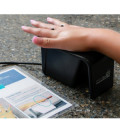Fitbit accelerometer to track postsurgical patients
A $100 wireless accelerometer from Fitbit — normally used by healthy people to measure their daily exercise progress — could revolutionize hospital care and perhaps post-acute care as well.
In a paper published in The Annals of Thoracic Surgery, researchers at the Mayo Clinic in Rochester, Minn., reported that attaching the accelerometer to the ankles of elderly patients recovering from elective cardiac surgery in the hospital enabled clinicians to measure how many steps each patient took on each day after their operations.
This first-of-its-kind experiment showed the association between a patient’s post-surgical mobility and length of stay and his or her discharge disposition to a skilled nursing facility, home health care or independent living at home.
For example, on the second recovery day, patients who would later be discharged to independent living at home walked six times as far as those who went to a nursing facility or to home health care. Similarly, by the end of the second day, the patients with the shortest hospital stays reached a median of 818 steps, compared to 514 and 223 steps in the intermediate and longer-stay groups, respectively.
[ Will smartwatches quash the mobile health device market? Read Smartwatches Could Outshine Wearable Fitness Gadgets. ]
These associations were not surprising, according to the study’s authors. However, they noted, “It is critical in the face of changing demographics and financial rules that we measure functional measures of recovery for individuals and populations. Functional status and variables such as mobility will impact discharge disposition, patient satisfaction, social support required, falls, hospital readmission, and ultimately health care costs.” In addition, they said, the Fitbit data gave them the ability to intervene early when a patient’s mobility was less than expected.
David J. Cook, MD, the study’s lead author, told InformationWeek Healthcare that up to now, the only source of in-hospital mobility data has been nursing notes. Nurses try their best to record this information, he said, but they’re busy and the data is often incomplete.
In contrast, Cook noted, the [Fitbit] data is 100% reliable. “You’re not dependent on someone reporting it or not reporting it. It’s objective and complete data. This technology represents the ability to acquire data on patients all the time.”
This change has profound implications for hospital care. For starters, doctors have anywhere, anytime access to this data online, allowing them to intervene earlier when patients are having difficulties. “By acquiring this data effectively and reliably, we were able to identify patients who were having trouble with mobility and intervene right there,” Cook said. As a result, patients who were having problems could see physical therapists earlier than they might have otherwise.
Second, he pointed out, the data allows clinicians to build models of “recovery norms” for certain kinds of patients who have had particular procedures. The next step is to look at how changes in practice affect those norms, Cook said. “For example, with strategies for earlier mobility or pain management, we can start to look at the impact of practice changes on patient recovery.”
Alone or in conjunction with other remote monitoring devices, accelerometers like Fitbit’s can also be used to measure the recovery of discharged patients at home or in post-acute-care facilities. For example, if a patient who has congestive heart failure goes home with a wireless accelerometer and starts to fail, they’ll move less, and the clinicians monitoring them can pick that up right away. “This [mobility] is likely to be predictive of patients who are going to have medical visits, whether to a doctor’s office, an ER or a hospital admission,” Cook said.
Cook believes that the same kind of technology will also be used to monitor patients in assisted living and skilled nursing facilities. “This is going to impact health and wellness in ways we haven’t been able to do before because we weren’t able to acquire accurate data and weren’t able to know what was normal and what wasn’t,” he said.
In the Mayo Clinic study, the accelerometer, which normally uploads data to a smartphone, instead sent the data to a radio antenna interfaced with an in-room computer. From there, the information was transmitted to the Fitbit website, where it was aggregated and displayed on a dashboard.
Cook said that alert values based on normative data were indispensable to helping nurses and doctors make use of the accelerator information. “We can look at 200 patients discharged after heart failure, and at who gets admitted and what their mobility changes were and what their blood pressure and heart rate changes were, and then we have an algorithm that says, of the 50 patients on your dashboard, 48 are in green, one is yellow and one is red. For the one in red, you pick up the phone and make a call.”









You must be logged in to post a comment Login